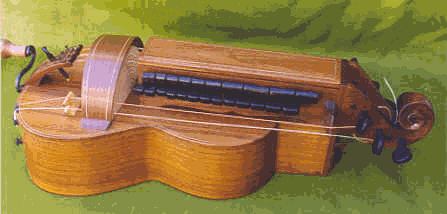
THE HURDY GURDY IN SPAIN

WHAT IS A HURDY GURDY ?
The Hurdy Gurdy is also known as: 'Drehleier' in German, 'Vielle à Roue' in French, 'Viola de Roda' en Catalan, 'Ghironda' in Italian, 'Zanfona' in Spanish, 'Brenka' in Basque,… It can be described as something as a violin where the friction on the strings is performed by the edge of a wooden wheel that turns inside the body of the instrument. The rotation of the wheel is performed by the right hand of the player on a crank, while the strings are pressed by the left hand fingers on a small keyboard.
THE TRADITION OF 'BASS STRING' INSTRUMENTS IN EUROPE
What are the "European folk musics"? There are probably many answers to this question. A common one would be: those inspired on the local musical traditions from each part of Europe. Then, the second difficulty appears when defining the meaning of "tradition".
Can the hurdy gurdy be considered as part of the musical tradition of Spain? Can the bagpipes be considered a traditional instrument in continental Europe? The answer to both questions can be "Yes", but to justify that, on both cases you need to look back to the origins, and mainly to the development of these instruments. In the Middle Ages, both bagpipes and hurdy-gurdies were instruments played by the minstrels throughout all the old European kingdoms. There are numerous representations of pipers and hurdy gurdy performers in the sculptures of Romanesque & Gothic cathedrals and churches, as well as on ancient illustrated books and icons. Together with harps, flutes, lutes, etc…, they were quite popular, at least until the Renaissance or even later.
However, it seems that along time the popularity of both bagpipes and hurdy-gurdies, progressively decayed until they just survived as a living rural tradition in certain localised regions. In the case of bagpipes we can think on places such as: Scotland, French Brittany, North of Spain, … But thinking on hurdy-gurdies the examples are not so evident. The fact is that at the end, the hurdy gurdy became a musical tradition inherited mainly by the guilds of the blind musicians in Europe. One of the many names given to this instrument in older times was (in Latin) lyra mendicorum: beggar's lyre.
After its 'glory days' in the Middle Ages, it seems that the main place in Europe where the hurdy gurdy was re-adopted by the aristocracy and became a fashionable instrument was France during the baroque period. Technical innovations continued being incorporated in the instrument centuries after its basic medieval configuration, becoming quite refined in its design, quality of woods, mechanisms and playing techniques, and such it has arrived until today.
THE SURVIVAL OF THE 'ZANFONA' IN SPAIN
There are several names for the hurdy gurdy in Spanish, but the most common one is 'zanfona', derived from another old name in Latin: 'symphonia'. Differently from France, in Spain the fate of this medieval instrument was… to be forgotten. Why? Probably, its primitive sound (compared for example to a violin or a guitar) did not seem to attract modern audiences as it used to at the days of the minstrels. That was also the case in many other parts of Europe.
However, not succeeding so much as the bagpipes ( which has remained as a very popular instrument in the villages of north Spain, Pyrenee regions, Balearic islands, …), the zanfona at least survived in the hands of humble blind musicians, who travelled along the Iberian peninsula, begging with their singed tales (as minstrels also used to do in medieval times). For that reason, the zanfonas that were found in Spain in the latest centuries were not so sophisticated instruments, compared to contemporary French ones. They were built with the shape of a guitar, using thick and rough wood, and basic string configurations. Even probably the playing technique of their performers was not too advanced, just needed to play a simple background melody for the stories they sang from village to village. As mentioned before, except for France this was the general fate of the hurdy gurdy in most European countries. Even Ukraine had a guild very similar to that of the blind musicians in Spain.
Fragment from the painting by Ramon Bayeu
(1746-1793): "El ciego músico" (The blind musician), kept in the Prado Museum
in Madrid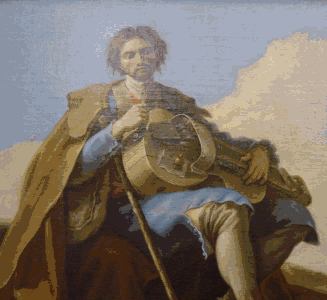
In Northwest Spain, one of the first illustrated personalities interested on recuperating this ancient instrument from the hands of the latest travelling blind musicians was Perfecto Feijoo. He was a pharmacist from the city of Pontevedra (Galicia) born in 1858, who dedicated his life to the research and preservation of the purest forms of the Galician rural folklore: the singing, the gaita bagpipes and their repertoire, the traditional clothing, and also the Galician zanfona. Although his work on the music for this instrument was not much more than the recording of a Galician song on a wax cylinder gramophone in 1907.
Perfecto Feijoo, playing the zanfona and
wearing the typical clothing of a blind beggar.
He actually bought them from one of these latest
travelling musicians in Galicia in early 20th century
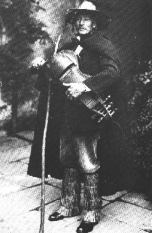
However, the first Spaniard doing a documented research on the zanfona was another Galician: Faustino Santalices, born in 1877 in the town of Bande (province of Ourense). In 1956 he published the first known Spanish study describing the characteristics and playing technique of the zanfona. He also recorded several albums between 1929 and 1953. In 1951 he founded in the city of Lugo a workshop-school of traditional Galician instruments, where they registered and reproduced the patterns of traditional gaita bagpipes, zanfonas, and several other ancient instruments. Since then, several other Spanish collectors and musicologists have been chasing the latest samples of the old zanfonas.
Photograph from Faustino Santalices, wearing
traditional Galician clothing and singing while playing his zanfona
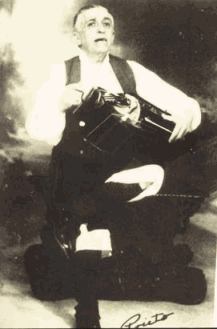
There has been recently published a CD (by the Spanish record company BOA), where Antón Seoane, musician of the Galician ensemble Milladoiro, puts together a collection of historical recordings of the zanfona (and occasionally gaita). The album embraces all the known work of Santalices, recorded from 1929 to 1949, including two compositions that were only recently discovered (http://www.cdroots.com/boa-zanfona.html).
CONTEMPORARY SPANISH ZANFONA PERFORMERS
Santalices recovered what he considered to be the traditional Galician zanfona. That was probably the same kind of hurdy gurdy that barely remained in the hands of the few latest travelling musicians in the rest Spain, until its extinction in early 20th century. The work of Santalices was followed by several traditional and folk musicians, who during the 60's and 70's started incorporating that instrument and playing technique in their performances. Such is the case of the Castilean folklorist and collector Ismael Peña (www.lachacona.com), who stills sings while playing his 18th century Galician zanfona in concerts. After the Galician folk music movement of the 70's, relevant names such as the singer Amancio Prada (www.amancioprada.com), the harpist Emilio Cao or the bands Fuxan Os Ventos and Milladoiro (www.milladoiro.com) have frequently used the traditional Galician zanfona. By the way, in the recent last CD from Milladoiro (O Niño do Sol), they have included an old recording of Faustino Santalices where he plays the zanfona while singing the traditional slow air Alalá das Mariñas, … and Milladoiro plays along (really touching, at least for me).
In recent years, younger Galician folk musicians such as Anxo Pintos from the band Berrogüetto, or Oscar Fernández-Sanjurjo from Os Cempes have progressed in the leading role of the zanfona in the Galician folk music. However, mostly playing zanfonas with the basic configuration of the instruments restored by Santalices.
In other parts of Spain, although the task of recovering the hurdy gurdy was inspired by the work from Santalices, both the makers and the musicians have preferred to evolve from that traditional zanfona concept towards the most modern design, construction and playing techniques, mainly from France. In central Spain, it must be mentioned the AIZ, Asociación Iberica de la Zanfona (Iberian Hurdy gurdy Association, www.zanfona.com) whose members have developed intense activities in the construction of these instruments, by the luthier Jesús Reolid, and Luis Delgado, Julio Garcia-Bilbao and Rafael Martín in the organisation of classes for playing, also bringing teachers such as: Maurizio Martinotti, Laurent Tixier, Pascal Leffeuvre, Isabelle Pignol, Gilles Chabenat, Patrick Boufard, Nigel Eaton, Valentin Clastrier and Anne Lise Foy.
Besides the Galician zanfonists, there are several other relevant performers from other parts of Spain, such as:
Another CD that I personally recommend about the Castillean traditional music played with the zanfona, is the one from Rafa Martín named: En la Espalda del Gigante (On the Back of the Giant), also from Tecnosaga.
Germán Díaz's work has to be remarked on exploring the possibilities of the zanfona in the jazz music with the band Rao Trio, and collaborating with the jazz double bass player Baldo Martinez (http://www.albacarma.com/CVGD.htm), as well as with Pascal Lefeuvre (http://www.albacarma.com/index.htm).
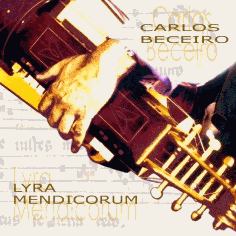
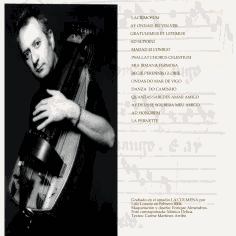
Carlos Beceiro, the specialist on string musical instruments in the band La Musgaña (www.lamusgana.com), has recorded a CD named Lyra Mendicorum. All the fourteen songs in this record are played by Carlos with his zanfona. These are songs from the medieval Codex Calixtinus, or inspired by the 'cantiga' poems of Martin Codax, the 13th century minstrel from the Galician city of Vigo. Besides his friends from La Musgaña, Quique and Jaime (bagpipes & other traditional woodwinds), some of the musicians playing with Carlos in Lyra Mendicorum are: the singer Maite Dono, Ana Alcaide (nickelharpa), Dimitris Psonis (saz,santur), Eduardo Laguillo Piano, Jaime Medina & Pablo Martin (percussion).
In summary, it can be said that the quality of the work done until now in Spain with the hurdy gurdy has progressed significantly and very interestingly during the last decades. Although when compared to the more extensive popularity of this instrument in other European countries, we could say it has just started, and it is in the hands of a talented, enthusiastic, but still reduced group of makers and performers.
My gratitude to Julio Garcia-Bilbao from AIZ and his expert advise for this article
Note : Several links to web pages have been included in this article,
allowing the reader to access more extensive information on particular musicians
or specific topics. It may happen that as time goes by, some of this links become
ineffective. Sorry for the inconvenience.
All material published in FolkWorld is © The Author via FolkWorld. Storage for private use is allowed and welcome. Reviews and extracts of up to 200 words may be freely quoted and reproduced, if source and author are acknowledged. For any other reproduction please ask the Editors for permission. Although any external links from FolkWorld are chosen with greatest care, FolkWorld and its editors do not take any responsibility for the content of the linked external websites.
